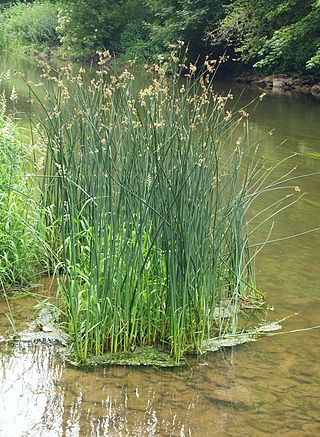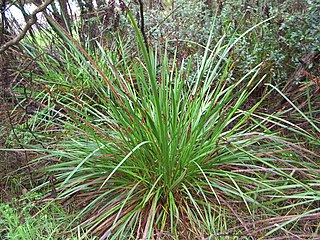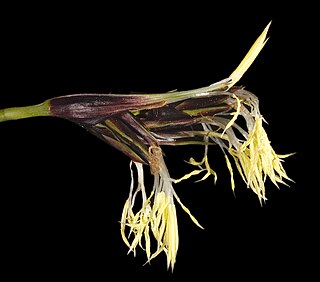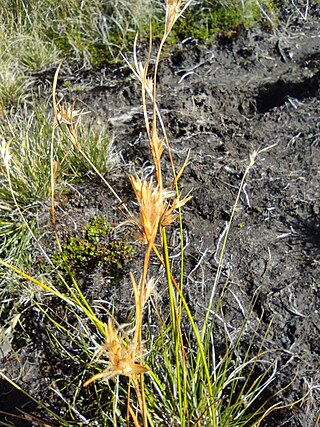Related Research Articles

The Cyperaceae are a family of graminoid (grass-like), monocotyledonous flowering plants known as sedges. The family is large, with some 5,500 known species described in about 90 genera, the largest being the "true sedges" genus Carex with over 2,000 species.

Schoenoplectus is a genus of plants in the sedge family with a cosmopolitan distribution. Note that the name bulrush is also applied to species in the unrelated genus Typha as well as to other sedges. The genus Schoenoplectus was formerly considered part of Scirpus, but recent phylogenetic data shows that they are not closely related.

Eleocharis is a virtually cosmopolitan genus of 250 or more species of flowering plants in the sedge family, Cyperaceae. The name is derived from the Greek words ἕλειος (heleios), meaning "marsh dweller," and χάρις (charis), meaning "grace." Members of the genus are known commonly as spikerushes or spikesedges. The genus has a geographically cosmopolitan distribution, with centers of diversity in the Amazon Rainforest and adjacent eastern slopes of the South American Andes, northern Australia, eastern North America, California, Southern Africa, and subtropical Asia. The vast majority of Eleocharis species grow in aquatic or mesic habitats from sea level to higher than 5,000 meters in elevation.
Mapania is a genus of plants in the family Cyperaceae. It contains 100 species, distributed in tropical regions of Africa, India, southern China, Southeast Asia, New Guinea, Australia, Central America, northern South America, and various oceanic islands.

Lepidosperma is a genus of flowering plant of the family Cyperaceae. Most of the species are endemic to Australia, with others native to southern China, southeast Asia, New Guinea, New Caledonia and New Zealand.

Schoenus is a predominately austral genus of sedges, commonly known as bogrushes, or veldrushes in South Africa. Species of this genus occur mainly in South Africa, Australia and Southeast Asia. Others are found in scattered locations worldwide, from Europe to Asia, North Africa and the Americas. Three species occur in the peatlands of southern South America, including S. antarcticus which is found in Tierra del Fuego, where it forms a component of hyperhumid Magellanic moorland.

Machaerina (twigrush) is a genus of flowering plants in the sedge family. Its species occur in tropical America, the West Indies, Malesia, Australia and the Pacific region. The name comes from the Greek machaira, alluding to the shape of the leaves in the type species – Machaerina restioides.

Tetraria is a genus of flowering plants in the sedge family, Cyperaceae, native to Tanzania, South Africa, Borneo, Australia and New Zealand.

Fuirena, called umbrella sedges or umbrella grasses, are a genus of flowering plants in the sedge family (Cyperaceae), with a worldwide distribution, chiefly in the tropics and temperate zones. They are named for Danish physician and early botanist Georg Fuiren, 1581–1628.

Carpha is a genus of flowering plants belonging to the family Cyperaceae.
References
- ↑ "Cyperus". The Plant List . Retrieved 20 March 2015.
- ↑ "Cyperus bonariensis", World Checklist of Selected Plant Families , Royal Botanic Gardens, Kew , retrieved 2018-01-18
- ↑ "Cyperus nudiceps", World Checklist of Selected Plant Families , Royal Botanic Gardens, Kew , retrieved 2018-01-17
- ↑ Prasad, V. P.; Simpson, D. A. (1 March 2012). "The status of Cyperus pertenuis and Cyperus scariosus (Cyperaceae)". Kew Bulletin. 67: 93–96. doi:10.1007/s12225-012-9339-7. S2CID 33077186.
- ↑ Tucker, Gordon C. (December 2013). "Two new Neotropical species of Cyperus (Cyperaceae)". Kew Bulletin. 68 (4): 619–623. doi:10.1007/s12225-013-9470-0. JSTOR 24717381. S2CID 35819078 . Retrieved 2 January 2022.
- ↑ "Cyperus stergiosii G.C.Tucker". Plants of the World Online . Board of Trustees of the Royal Botanic Gardens, Kew. 2017. Retrieved 2 January 2022.
- ↑ "Cyperus steudneri (Boeckeler) Larridon". Kew Science – Plants of the World Online. Retrieved 12 June 2022.
- ↑ "Cyperus stewartii", World Checklist of Selected Plant Families , Royal Botanic Gardens, Kew , retrieved 2018-01-17
Cyperus .